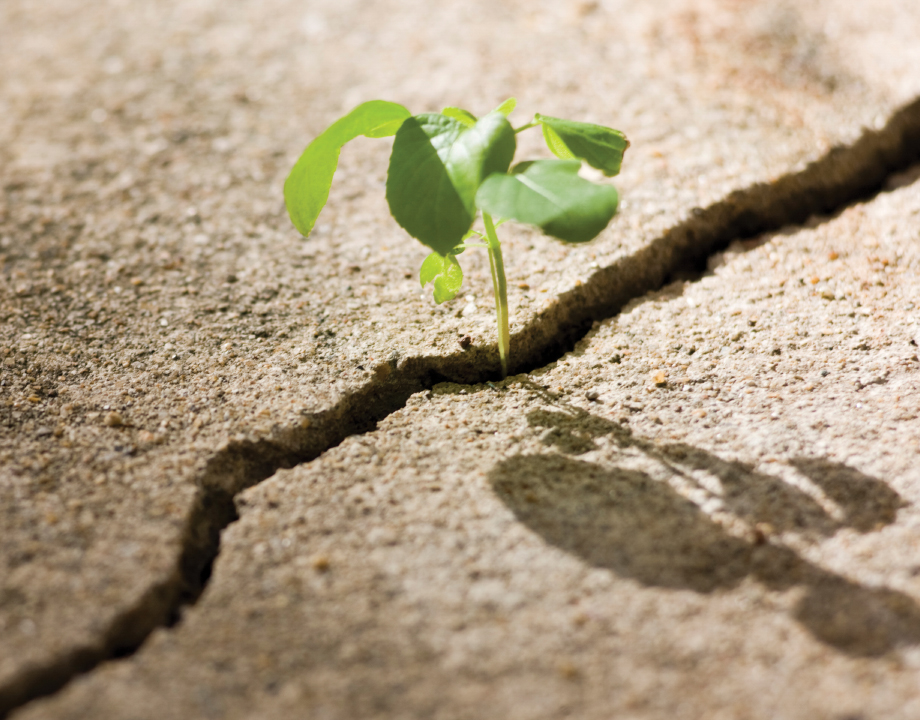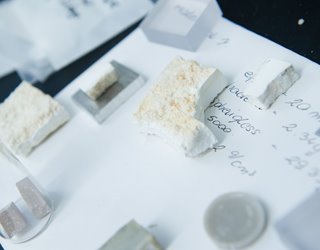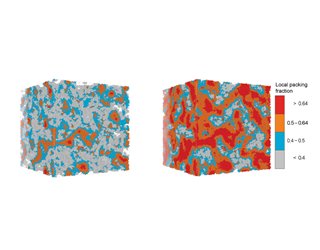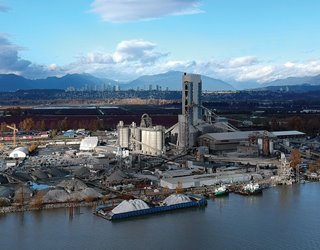Low-Carbon Concrete Can Fight Global Warming
Low-Carbon Concrete Can Fight Global Warming


Engineers are scrambling to find a way to reduce the greenhouse gas impact of the ubiquitous construction material.
There’s likely not a more flexible material than concrete. That’s not a measure of its elasticity—when concrete sets, it’s as hard as rock—but of its uses. Concrete is found all over the modern world, from the swooping rooflines of the TWA Terminal at John F. Kennedy Airport in New York to the uninspiring Brutalist blocks on many university campuses and the unremarkable sidewalks, highway bridges, and other utilitarian, nearly invisible infrastructure. So critical to the modern urban landscape is concrete that when China went on a city-building spree between 2011 and 2013, it poured 6.6 billion tons of the stuff, more than the U.S. used in the entire 20th century.
Worldwide, about 4.4 billion tons is produced each year, enough to build a 47-foot-tall, 10-foot-thick wall completely around the equator.
Making all that concrete has a measureable impact, from increasing the “urban heat island” effect to reducing the ability of rain water to percolate into the soil. The largest effect is likely the most invisible: carbon emissions.
The production of concrete is responsible, by some estimates, for as much as 10 percent of global carbon dioxide emissions, enough to be considered a major contributor. By comparison, the International Energy Agency calculates that worldwide heating and electricity production for residential use accounts for 11.3 percent of CO2 emissions.
Unlike fossil fuels, which already have suitable replacements that just need to be scaled up, finding something else that can be poured like a liquid, but hardens like stone, is cheap but available in massive quantities will not be easy.
“We’ve been using concrete since the Romans,” said Bruno Lafont, former CEO of the European construction materials company LafargeHolcim Ltd. “No one yet has come up with a substitute. Instead we’re pushing the boundaries, developing new materials and products.”
Given the impact that has now become apparent, research teams around the world are pursuing a number of impressive and effective technologies to reduce the carbon footprint of concrete production and use as a top priority. Some are being deployed cost-effectively today, while other, potentially even better solutions, are being developed in labs. The biggest hurdle might not be coming up with low-carbon solutions, but getting the construction industry to adopt them.
Concrete is essentially a mixture of paste and rocks, and has been used in construction since the days of the Roman Pantheon—and perhaps the Egyptian Pyramids. The formulations have changed since antiquity, however, and today's version is generally made from Portland cement and water, plus small rocks and sand referred to as aggregate. The cement reacts with the water to create a material that when cured can be nearly as strong as natural stone.
But every ton of cement creates 900 kg of CO2 emissions. It is the Portland cement, which comprises anywhere between 7 to 15 percent of the concrete, that is responsible for most emissions—specifically, it is the production of clinker, which is the binding agent, that is the main culprit. Clinker is made by heating limestone (CaCO3) and clay (Al2O3SiO2Fe2O3+2H2O) to 1,450 °C to produce a more reactive calcium oxide.
Supplying all that heat requires a great deal of fossil fuel, but that’s not the half of it. The purpose of the heat is to get CaO from CaCO3 by means of driving off CO2. Of the 2.5 billion tons of CO2 emitted last year from cement production, 1.5 billion was from the chemical reaction that occurs when the ingredients are combined and heated.
Given that the core processes that make concrete involve creating and driving off carbon dioxide, the industry is considered to be one of the hardest to decarbonize. But engineers are trying.
Eric Trusiewicz spent years working in the concrete industry and is now a Sloan Fellow at Stanford University. His research specialization is “the decarbonization of heavy industry,” and he described a number of “levers” that his research has identified for reducing the carbon footprint of concrete production.
The first lever has been a continuous improvement in operational efficiency, going back three decades. Perhaps most significant was the move from a wet manufacturing process—in which the material started as a slurry, necessitating vast amounts of energy for evaporation—to a dry one. Other advancements include pre-heater towers with cyclones along with the increasing use of data for process optimization.
Further Reading: Building the Ultimate Carbon Capture Tree
Another lever is the use of substitutes for coal as fuel for process heat. In Europe, where the concrete industry is subject to carbon emissions cap-and-trade policy, biomass and municipal waste are being used as alternative fuels.
One out-of-the-box approach is a project at MIT pursuing an electrochemical process. The process, according to Leah Ellis, a postdoc who worked with Yet-Ming Chiang on the project, functions like a battery in which pulverized limestone is dissolved in an acid at one electrode and calcium hydroxide, or lime, precipitates out at the other. The lime can then be used to synthesize alite (Ca3SiO5), the “majority cementitious phase in ordinary Portland cement,” Ellis said, with substantially reduced emissions. The process also extracts a stream of chemically pure CO2 which can be utilized or sequestered.
One drawback is that the resulting cement requires substantial cure times, and the process demands substantial amounts of electricity, which would have to be renewable to result in reduced emissions.
A third lever lies in finding alternatives to clinker. Reducing the “clinker factor” will generally reduce the amount of embodied carbon in the cement.
According to Andrew Minson, concrete and sustainable construction director at the Global Cement and Concrete Association, these substitutes, sometimes called secondary cementitious materials, include fly ash, ground granulated blast-furnace slag, as well as calcine clays, volcanic ash, and more recently waste glass. A new development coming from the Swiss Federal Institute of Technology in Lausanne, or EPFL, produced a cement made from a blend of limestone and calcined clay that they call L3, which they claim can reduce carbon footprint by 40 percent.
Optimizing the amount of cement used in the concrete is another lever. Cement provides strength to the concrete, and since it is relatively cheap—and structural failures are unacceptable—it had long been common practice to over-specify and overdesign concrete structures. While having large margins of safety at every step of the process had once seemed like the prudent approach, it now is seen as wasteful and, in an era of climate concerns, even dangerous.
“If there is a priority placed on low carbon or material use,” Minson said, “then the versatility [of concrete] enables designers to optimize according to those new criteria.”
It’s easy and cheap to design and build a beam with a simple rectangular cross section, but that beam could contain a lot of excess material. Some designers have started thinking about cement as more like a valuable material.
Tony Saracino, senior sustainability success manager at Autodesk, says his company's construction management software has been integrated with a newly released tool called the Embodied Carbon in Construction Calculator (EC3) developed by Skanska.
“The BIM360 Connector allows you to connect your models up in the cloud, to the EC3 tool, which allows you to assign the materials based on the environmental product declarations and then provides a 3D model of your project, with a stoplight indicator, which tells you if more carbon savings are possible,” Saracino said. Included in the EC3 dataset are a variety of low-carbon concrete options.
Further Reading: Ancient Roman Concrete Stands the Test of Time
According to Stacy Smedley, director of sustainability at Skanska, a key developer of the tool, users in a pilot achieved a 30 percent reduction in embedded carbon, with no appreciable cost increase, just by making informed choices.
Another way to use less concrete is to make the material stronger, pound for pound. That’s the premise behind recent work at MIT, where Roland Pellenq and his team claim to have found the optimal ratio of calcium to silica, which, if combined with “some molecular-scale design,” would reduce cement usage and cut carbon emissions by as much as 50 percent. A group at Exeter University in England has developed a nano-engineered graphene-concrete that displays an “increase of up to 146 percent in the compressive and 79.5 percent in the flexural strength.” Their concrete also displays dramatically reduced water permeability, making it ideal for flood-prone areas.
Other groups are reexamining curing times to see if the strength of poured concrete has been underestimated. Strength in poured concrete is usually measured at the 28-day mark, but since it continues to increase as it cures, the ultimate strength will be higher still. Underestimating the final strength could easily result in over-design and the use of more cement, with its corresponding emissions.
Lionel Lemay, executive vice president at the National Ready Mixed Concrete Association, describes a method of using calibrated sensors that correlate heat given off during curing with the strength of the material. These can be used in conjunction with a smartphone app to determine the strength of curing concrete in real time.
Another application of sensors enables companies to move from site-batching concrete to ready-mix concrete, which has more quality control and may offer significant emission-reduction potential. GCP Applied Technologies, a supplier of construction materials based in Cambridge, Mass., has a system that uses artificial intelligence and widespread use of sensors to allow for tight specification on the ready-mix being delivered. The system, called Verifi, monitors key parameters and automatically adds water or dry ingredients within pre-set limits during transport. The goal is for each batch of concrete to meet specifications when it arrives on the job site, with fewer batches being rejected, while optimizing the amount of cement used.
Every bit helps, but when world demand for concrete is measured in billions of tons, the industry will still be producing gigatons of carbon dioxide no matter how efficient it becomes. Some companies are taking on the rest of the equation by pursuing technologies that can capture the carbon dioxide resulting from concrete production.
LafargeHolcim, the multinational construction materials manufacturer, in July 2019 launched a project to capture and reuse CO2 from a cement plant. In partnership with the French oil company, Total, and Svante, a carbon capture startup based in Burnaby, B.C., the aim of the CO2MENT project is to “build the world’s first full-cycle solution to capture and reuse CO2 from a cement plant while also reducing greenhouse gas emissions.” Rolling out in three phases, the goal is to purify, separate, and utilize carbon dioxide onsite. The $21 million pilot-scale system at the Richmond Cement Plant near Vancouver is expected to replace 50 percent of fossil fuel usage and reduce emissions by 20 percent.
Other companies are making perhaps more dramatic efforts, looking to inject CO2 into concrete as it’s being made, as a form of sequestration that brings along a number of collateral benefits.
CarbonCure Technologies is a Canadian company that makes a system that seamlessly integrates into a plant’s existing batching system and injects CO2 into ordinary ready-mix concrete. The CO2 is then chemically bonded into the concrete, with the added benefit of actually increasing its compressive strength.
Every pound of CO2 injected into the concrete reduces the net carbon footprint.
Christie Gamble, CarbonCure’s director of sustainability, says that if the technology were to be adopted universally, it could lock away 700 million tons of CO2 every year. One 12-story building recently completed in Atlanta, made with CarbonCure treated concrete, contains 1.5 million pounds of sequestered CO2.
Another company working to sequester carbon dioxide in concrete is Solidia Technologies of Piscataway, N.J. Its proprietary process involves injecting CO2 and water into a loosely packed mixture of cement and sand. The CO2 reacts with those constituents to form solid calcium carbonate and silica in a product that is carbon neutral.
When that cement is used to make concrete, it is cured using carbon dioxide instead of water and absorbs up to 70 percent of that CO2. Not only does the process save on water—which is also a selling point in arid regions—but the curing process is complete in just 24 hours.
Solidia claims its process has the potential to “eliminate at least 1.5 GT of CO2, save 3 trillion liters of fresh water, reduce energy consumption by as much as 260 million barrels of oil.”
Finally, Blue Planet of Los Gatos, Calif., has developed a process that converts flue gas into a solid carbonate coating that is then applied to small pebbles (made from upcycled demolition debris). The resulting synthetic limestone is 44 percent carbon dioxide by mass. Because these pebbles themselves are carbon negative, adding them to concrete can offset the CO2 emitted by other parts of the concrete manufacturing process. Depending on other factors, concrete using those pebbles as aggregate can be net carbon neutral or even carbon negative.
From Our Archives: A Precast Masonry Arch Bridge that Lasts Centuries
The technologies to reduce the carbon impact of concrete are either on the market or close to commercialization. The biggest challenge may not be in the technology, but the will to deploy it. The construction industry is by nature very conservative—and for good reason. When an engineer, contractor, or concrete supplier signs off on a project to build a 90-story skyscraper or a 6-lane highway overpass, they are putting their reputation, and perhaps their careers on the line. Many lives could be lost if those projects were to fail. Even though they have done their part correctly, they have to trust that the concrete being used will perform as advertised. It will take time for that level of confidence in new products and processes to become widespread.
Adding to this challenge is the fact that concrete is a commodity used in great quantities, with cost being a major competitive factor. That means when a new company hits the market, they need to be big right away in order to compete. Companies like Solidia are now making concrete garden pavers with 70 percent reduced carbon footprints as a way of generating cash flow as they scale up and make their way across the commercialization “valley of death.”
The wait should not be long. Interest among customers in sustainable practices is there and growing. And with tools like EC3, showing builders which materials use less carbon is now easy. Meanwhile, processes like CarbonCure can be retrofitted onto an existing plant in a single day with no capital expenditures and no changes to their material or production method.
The way forward is being paved with green concrete innovations.
RP Siegel is an engineering and science writer based in Rochester, N.Y.
Worldwide, about 4.4 billion tons is produced each year, enough to build a 47-foot-tall, 10-foot-thick wall completely around the equator.
Making all that concrete has a measureable impact, from increasing the “urban heat island” effect to reducing the ability of rain water to percolate into the soil. The largest effect is likely the most invisible: carbon emissions.
The production of concrete is responsible, by some estimates, for as much as 10 percent of global carbon dioxide emissions, enough to be considered a major contributor. By comparison, the International Energy Agency calculates that worldwide heating and electricity production for residential use accounts for 11.3 percent of CO2 emissions.
Unlike fossil fuels, which already have suitable replacements that just need to be scaled up, finding something else that can be poured like a liquid, but hardens like stone, is cheap but available in massive quantities will not be easy.
“We’ve been using concrete since the Romans,” said Bruno Lafont, former CEO of the European construction materials company LafargeHolcim Ltd. “No one yet has come up with a substitute. Instead we’re pushing the boundaries, developing new materials and products.”
Given the impact that has now become apparent, research teams around the world are pursuing a number of impressive and effective technologies to reduce the carbon footprint of concrete production and use as a top priority. Some are being deployed cost-effectively today, while other, potentially even better solutions, are being developed in labs. The biggest hurdle might not be coming up with low-carbon solutions, but getting the construction industry to adopt them.
Core Processes
Concrete is essentially a mixture of paste and rocks, and has been used in construction since the days of the Roman Pantheon—and perhaps the Egyptian Pyramids. The formulations have changed since antiquity, however, and today's version is generally made from Portland cement and water, plus small rocks and sand referred to as aggregate. The cement reacts with the water to create a material that when cured can be nearly as strong as natural stone.
But every ton of cement creates 900 kg of CO2 emissions. It is the Portland cement, which comprises anywhere between 7 to 15 percent of the concrete, that is responsible for most emissions—specifically, it is the production of clinker, which is the binding agent, that is the main culprit. Clinker is made by heating limestone (CaCO3) and clay (Al2O3SiO2Fe2O3+2H2O) to 1,450 °C to produce a more reactive calcium oxide.
Supplying all that heat requires a great deal of fossil fuel, but that’s not the half of it. The purpose of the heat is to get CaO from CaCO3 by means of driving off CO2. Of the 2.5 billion tons of CO2 emitted last year from cement production, 1.5 billion was from the chemical reaction that occurs when the ingredients are combined and heated.
Given that the core processes that make concrete involve creating and driving off carbon dioxide, the industry is considered to be one of the hardest to decarbonize. But engineers are trying.
Eric Trusiewicz spent years working in the concrete industry and is now a Sloan Fellow at Stanford University. His research specialization is “the decarbonization of heavy industry,” and he described a number of “levers” that his research has identified for reducing the carbon footprint of concrete production.
The first lever has been a continuous improvement in operational efficiency, going back three decades. Perhaps most significant was the move from a wet manufacturing process—in which the material started as a slurry, necessitating vast amounts of energy for evaporation—to a dry one. Other advancements include pre-heater towers with cyclones along with the increasing use of data for process optimization.
Further Reading: Building the Ultimate Carbon Capture Tree
Another lever is the use of substitutes for coal as fuel for process heat. In Europe, where the concrete industry is subject to carbon emissions cap-and-trade policy, biomass and municipal waste are being used as alternative fuels.
One out-of-the-box approach is a project at MIT pursuing an electrochemical process. The process, according to Leah Ellis, a postdoc who worked with Yet-Ming Chiang on the project, functions like a battery in which pulverized limestone is dissolved in an acid at one electrode and calcium hydroxide, or lime, precipitates out at the other. The lime can then be used to synthesize alite (Ca3SiO5), the “majority cementitious phase in ordinary Portland cement,” Ellis said, with substantially reduced emissions. The process also extracts a stream of chemically pure CO2 which can be utilized or sequestered.
One drawback is that the resulting cement requires substantial cure times, and the process demands substantial amounts of electricity, which would have to be renewable to result in reduced emissions.
A third lever lies in finding alternatives to clinker. Reducing the “clinker factor” will generally reduce the amount of embodied carbon in the cement.
According to Andrew Minson, concrete and sustainable construction director at the Global Cement and Concrete Association, these substitutes, sometimes called secondary cementitious materials, include fly ash, ground granulated blast-furnace slag, as well as calcine clays, volcanic ash, and more recently waste glass. A new development coming from the Swiss Federal Institute of Technology in Lausanne, or EPFL, produced a cement made from a blend of limestone and calcined clay that they call L3, which they claim can reduce carbon footprint by 40 percent.
Ultimate Strength
Optimizing the amount of cement used in the concrete is another lever. Cement provides strength to the concrete, and since it is relatively cheap—and structural failures are unacceptable—it had long been common practice to over-specify and overdesign concrete structures. While having large margins of safety at every step of the process had once seemed like the prudent approach, it now is seen as wasteful and, in an era of climate concerns, even dangerous.
“If there is a priority placed on low carbon or material use,” Minson said, “then the versatility [of concrete] enables designers to optimize according to those new criteria.”
It’s easy and cheap to design and build a beam with a simple rectangular cross section, but that beam could contain a lot of excess material. Some designers have started thinking about cement as more like a valuable material.
Tony Saracino, senior sustainability success manager at Autodesk, says his company's construction management software has been integrated with a newly released tool called the Embodied Carbon in Construction Calculator (EC3) developed by Skanska.
“The BIM360 Connector allows you to connect your models up in the cloud, to the EC3 tool, which allows you to assign the materials based on the environmental product declarations and then provides a 3D model of your project, with a stoplight indicator, which tells you if more carbon savings are possible,” Saracino said. Included in the EC3 dataset are a variety of low-carbon concrete options.
Further Reading: Ancient Roman Concrete Stands the Test of Time
According to Stacy Smedley, director of sustainability at Skanska, a key developer of the tool, users in a pilot achieved a 30 percent reduction in embedded carbon, with no appreciable cost increase, just by making informed choices.
Another way to use less concrete is to make the material stronger, pound for pound. That’s the premise behind recent work at MIT, where Roland Pellenq and his team claim to have found the optimal ratio of calcium to silica, which, if combined with “some molecular-scale design,” would reduce cement usage and cut carbon emissions by as much as 50 percent. A group at Exeter University in England has developed a nano-engineered graphene-concrete that displays an “increase of up to 146 percent in the compressive and 79.5 percent in the flexural strength.” Their concrete also displays dramatically reduced water permeability, making it ideal for flood-prone areas.
Other groups are reexamining curing times to see if the strength of poured concrete has been underestimated. Strength in poured concrete is usually measured at the 28-day mark, but since it continues to increase as it cures, the ultimate strength will be higher still. Underestimating the final strength could easily result in over-design and the use of more cement, with its corresponding emissions.
Lionel Lemay, executive vice president at the National Ready Mixed Concrete Association, describes a method of using calibrated sensors that correlate heat given off during curing with the strength of the material. These can be used in conjunction with a smartphone app to determine the strength of curing concrete in real time.
Another application of sensors enables companies to move from site-batching concrete to ready-mix concrete, which has more quality control and may offer significant emission-reduction potential. GCP Applied Technologies, a supplier of construction materials based in Cambridge, Mass., has a system that uses artificial intelligence and widespread use of sensors to allow for tight specification on the ready-mix being delivered. The system, called Verifi, monitors key parameters and automatically adds water or dry ingredients within pre-set limits during transport. The goal is for each batch of concrete to meet specifications when it arrives on the job site, with fewer batches being rejected, while optimizing the amount of cement used.
Neutral, or even Negative
Every bit helps, but when world demand for concrete is measured in billions of tons, the industry will still be producing gigatons of carbon dioxide no matter how efficient it becomes. Some companies are taking on the rest of the equation by pursuing technologies that can capture the carbon dioxide resulting from concrete production.
LafargeHolcim, the multinational construction materials manufacturer, in July 2019 launched a project to capture and reuse CO2 from a cement plant. In partnership with the French oil company, Total, and Svante, a carbon capture startup based in Burnaby, B.C., the aim of the CO2MENT project is to “build the world’s first full-cycle solution to capture and reuse CO2 from a cement plant while also reducing greenhouse gas emissions.” Rolling out in three phases, the goal is to purify, separate, and utilize carbon dioxide onsite. The $21 million pilot-scale system at the Richmond Cement Plant near Vancouver is expected to replace 50 percent of fossil fuel usage and reduce emissions by 20 percent.
Other companies are making perhaps more dramatic efforts, looking to inject CO2 into concrete as it’s being made, as a form of sequestration that brings along a number of collateral benefits.
CarbonCure Technologies is a Canadian company that makes a system that seamlessly integrates into a plant’s existing batching system and injects CO2 into ordinary ready-mix concrete. The CO2 is then chemically bonded into the concrete, with the added benefit of actually increasing its compressive strength.
Every pound of CO2 injected into the concrete reduces the net carbon footprint.
Christie Gamble, CarbonCure’s director of sustainability, says that if the technology were to be adopted universally, it could lock away 700 million tons of CO2 every year. One 12-story building recently completed in Atlanta, made with CarbonCure treated concrete, contains 1.5 million pounds of sequestered CO2.
Another company working to sequester carbon dioxide in concrete is Solidia Technologies of Piscataway, N.J. Its proprietary process involves injecting CO2 and water into a loosely packed mixture of cement and sand. The CO2 reacts with those constituents to form solid calcium carbonate and silica in a product that is carbon neutral.
When that cement is used to make concrete, it is cured using carbon dioxide instead of water and absorbs up to 70 percent of that CO2. Not only does the process save on water—which is also a selling point in arid regions—but the curing process is complete in just 24 hours.
Solidia claims its process has the potential to “eliminate at least 1.5 GT of CO2, save 3 trillion liters of fresh water, reduce energy consumption by as much as 260 million barrels of oil.”
Finally, Blue Planet of Los Gatos, Calif., has developed a process that converts flue gas into a solid carbonate coating that is then applied to small pebbles (made from upcycled demolition debris). The resulting synthetic limestone is 44 percent carbon dioxide by mass. Because these pebbles themselves are carbon negative, adding them to concrete can offset the CO2 emitted by other parts of the concrete manufacturing process. Depending on other factors, concrete using those pebbles as aggregate can be net carbon neutral or even carbon negative.
From Our Archives: A Precast Masonry Arch Bridge that Lasts Centuries
The technologies to reduce the carbon impact of concrete are either on the market or close to commercialization. The biggest challenge may not be in the technology, but the will to deploy it. The construction industry is by nature very conservative—and for good reason. When an engineer, contractor, or concrete supplier signs off on a project to build a 90-story skyscraper or a 6-lane highway overpass, they are putting their reputation, and perhaps their careers on the line. Many lives could be lost if those projects were to fail. Even though they have done their part correctly, they have to trust that the concrete being used will perform as advertised. It will take time for that level of confidence in new products and processes to become widespread.
Adding to this challenge is the fact that concrete is a commodity used in great quantities, with cost being a major competitive factor. That means when a new company hits the market, they need to be big right away in order to compete. Companies like Solidia are now making concrete garden pavers with 70 percent reduced carbon footprints as a way of generating cash flow as they scale up and make their way across the commercialization “valley of death.”
The wait should not be long. Interest among customers in sustainable practices is there and growing. And with tools like EC3, showing builders which materials use less carbon is now easy. Meanwhile, processes like CarbonCure can be retrofitted onto an existing plant in a single day with no capital expenditures and no changes to their material or production method.
The way forward is being paved with green concrete innovations.
RP Siegel is an engineering and science writer based in Rochester, N.Y.







